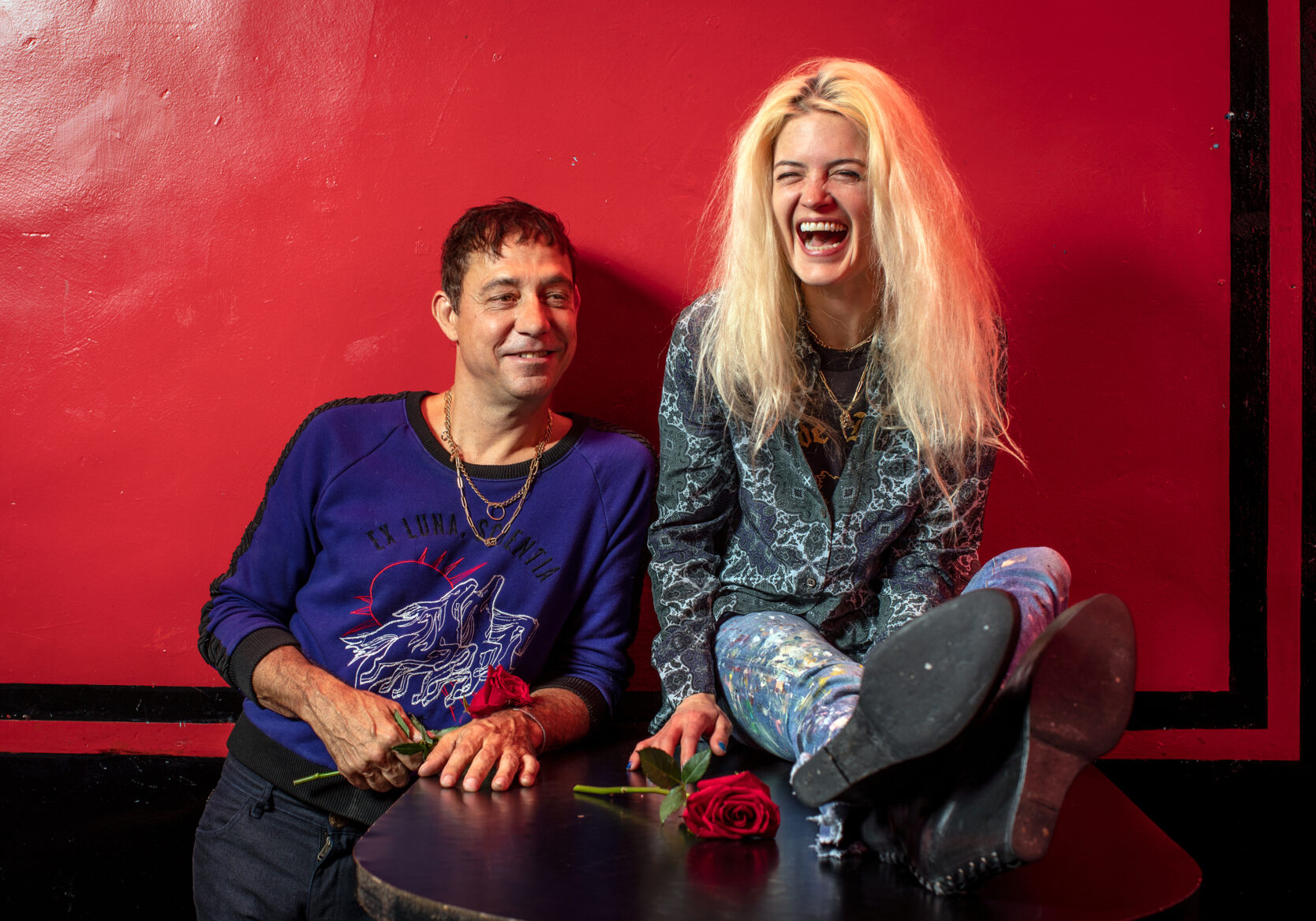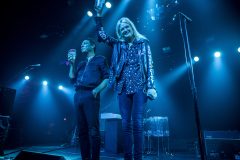At the old Mayan Theatre in downtown Los Angeles, fans are wound up for a smoldering night of jagged, turbocharged punk and deep blues. The Kills have come to reignite the present and reflect on their past amid the room’s angular, pre-Columbian temple decor and packed dance floor. At stage left is singer Alison Mosshart, with a mane of startling platinum, wailing to the riffs of “Murdermile,” a bleak tune from 2005. She grabs her mic stand and snaps her head forward and back, convulsing to the raw bursts of guitar from her creative soulmate, Jamie Hince, now blasting through his amplifiers.
Together, Mosshart and Hince pause between riffs to growl and purr, “It’s a train wreck/You got me on the wrong track, honey.”
This is only their third night back in the spotlight since 2019, part of a short run of shows to signify their return from the forced hibernation of the COVID-19 pandemic. And they’ve gone back in time for the occasion, returning to their original minimalist form: just two of them onstage, dressed in black, with whiplash guitars and crackling drum machine.
“It’s pretty hot up here,” Hince joked to Mosshart between songs at the Mayan. “I’ve been sitting on my couch for the last two years with only two things to do a day.”
The Kills were derailed like most artists during the unsettling early days of COVID. At the beginning of 2020, Hince and Mosshart were well into writing their next album, when all activity was frozen in place that March by disease, lockdowns, and uncertainty. That hiatus is finally over.
Being back in front of an audience after COVID was “surreal and amazing,” says Mosshart later, noting the band got used to playing with an expanded lineup of musicians this last decade. This time, their preparation only included the two of them. “The four rehearsals were basically us trying to find these drum tracks and trying to edit them.”
The most visible signs that The Kills are back in action was this month’s brief run of concerts: two shows at the Mayan, two more last week at Brooklyn Steel in New York, and a June 4 spot opening for Jack White at an amphitheater in Northern California. The indie-rock duo also hosted exhibitions of their original Polaroid photographs at the two Morrison Hotel Gallery spaces in L.A. and New York.
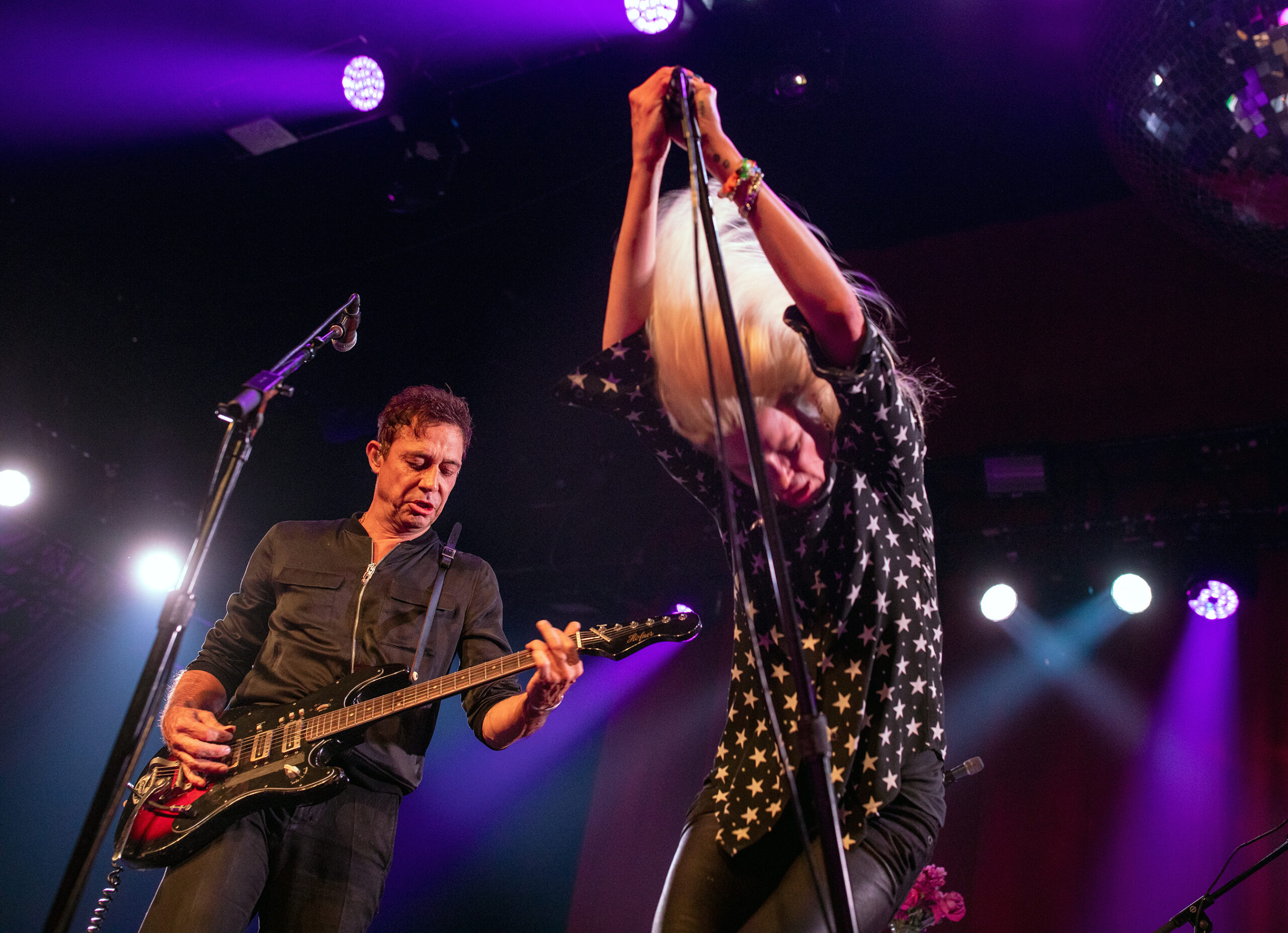
They expect to finish recording a new album this summer, their first since 2016’s Ash and Ice, and to finally go on a major tour again sometime next year. Hince and Mosshart spent a few days recently recording with Beck in Los Angeles, and in the coming weeks, will travel to London to work with Paul Epworth, Grammy-winning producer of Adele, U2, and Paul McCartney.
In the interim, The Kills have just issued an expanded edition of their second album, 2005’s No Wow, on two slabs of vinyl – one for the original album, the other for a crisp new digital remix by Tchad Blake. It adds contemporary energy to the torrid title song, to agitated rockers like “Murdermile” and “Love Is a Deserter,” and “Rodeo Town,” a ballad as warm and frayed as a Lucinda Williams tune.
“That was the last record of that different era where we played everything live on tape,” says Hince. “I didn’t want to do anything retro and release something nostalgic. And then Alison came up with this idea: ‘What about digitally remixing it with Tchad Blake?’ – who’s mixed our last three records. And I thought, yeah, we can release our old record and shine a bit of 2022 light on it with digital sonics.”
No Wow was recorded in 2004 at Black Box Studios in the French countryside, near the Loire Valley, and then in New York City’s Sear Sound Studios, where it was also mixed. The Blake mix was a chance to reinterpret the songs with contemporary ears, unearth new details and shadings, without tearing apart the original. Like everything for them about making records then, time and money were short.
“It was quite rushed,” Hince says of the original mix, which was done by the album’s engineer, John Agnello. “We were present for all the mixing, but I absolutely don’t remember any of that, and I’ve got a fantastic memory.”
“I love that mix,” Mosshart adds. “That was the state of our career then: You get it all done in the same studio before you go home. You don’t send it to a mixer. But John did an incredible job and I think it sounds like the time very much. What’s cool about this other version is it sounds like this time and that’s awesome. What a treat to have both.”
The next album will also be a mix of past and present. Long before Epworth’s current life of platinum records and Grammys, he was The Kills’ soundman for their first tour, a long no-frills road trip in 2002-2003. They were starving artists then, scraping by in a van and low-rent hotel rooms, instruments held together with duct tape. “We’ve toured and lived together in the hardest of situations,” says Mosshart, who calls the plan to reunite decades later “really interesting.”
They’ve already visited Epworth’s elegant studio built in a North London church, a modern facility with an arched ceiling and stained glass. Later, they FaceTime’d with Epworth as he vacationed on a beach in Mexico, which couldn’t have been further from the Boho rock and roll life they once knew together.
“We literally would drive around in an old van that would break down and he’d be carrying the gear with us,” says Hince with a laugh. Times have changed radically for Epworth, and The Kills have high hopes for their coming collaboration. “It’d be great to have somebody that’s really got chops now for some modern music, but that knew our band at the beginning.”
With Beck, one of the new songs recorded is “Bullet Sound,” something The Kills had in progress for years, never quite feeling it was finished. Beck’s presence changed that. Hince says having another accomplished collaborator in the room means a fresh perspective. “It’s getting out of your own head,” says Mosshart.
While the pandemic delayed The Kills’ plans for recording, the band is usually slow to release new material anyway, sharing only a fraction of the music they create together. Mosshart has said she and Hince have mountains of written songs and ideas that have been discarded or left unfinished. (Mosshart released a handful of solo singles – her first – during the pandemic. And The Kills put out a cover of the T.Rex classic “Cosmic Dancer.”)
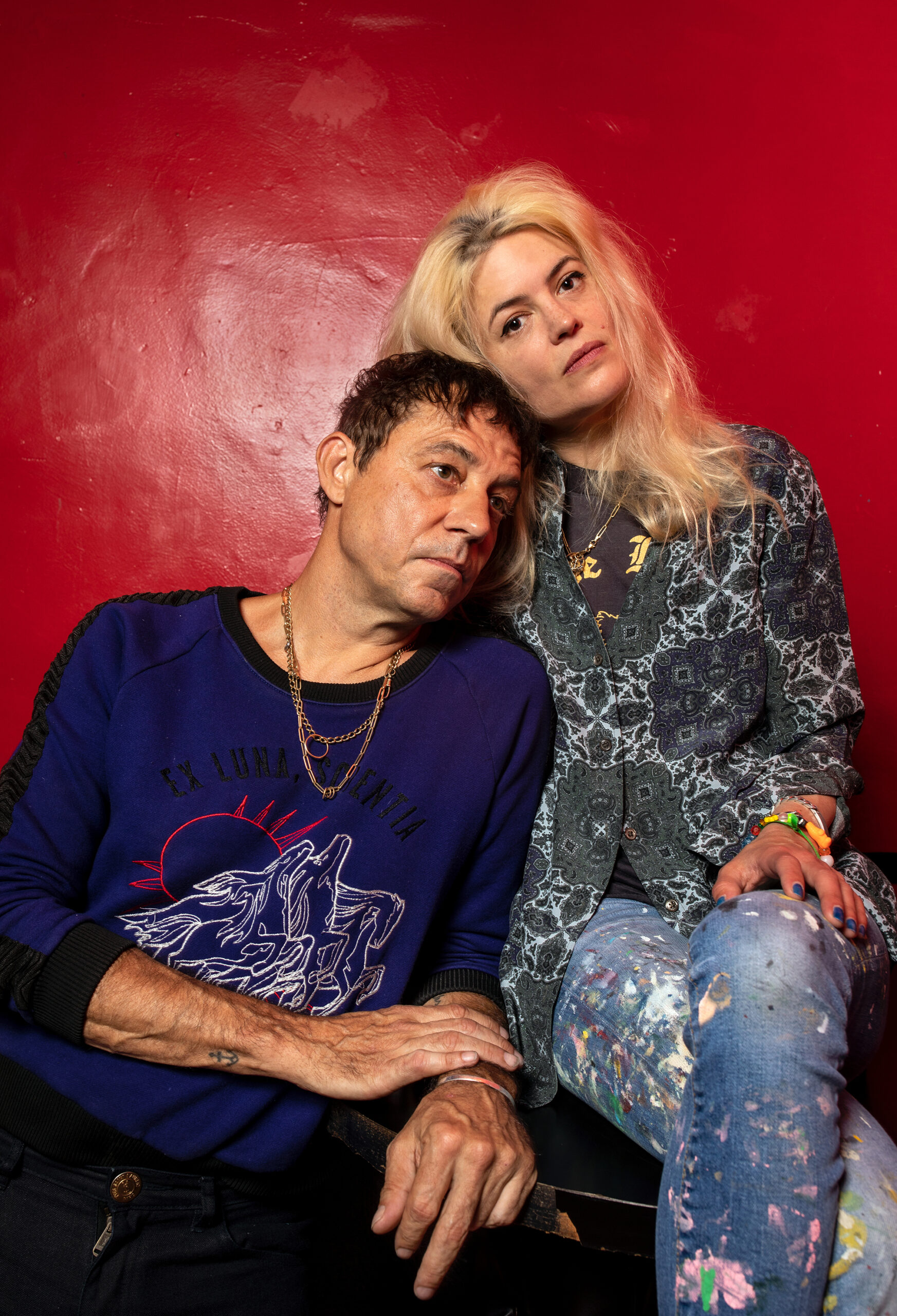
“I think if it was left up to Alison, she’d release everything,” says Hince. “I like that attitude, but when it comes to us, I can’t do it. We are really different in that respect. Alison is more like, ‘We’ve succumbed to this art thing, and this is what we’ve chosen. So everything we do is art and everything we do deserves to be heard.’ And I’m more the way I was brought up – kind of struggling with my being an imposter. I just feel too ordinary, and I want everything to be super special and until I get that feeling, I don’t want to let it go. I think it kind of makes a good team.”
“You see what I go through?” says Mosshart with a laugh. “I’m going to dig and claw things away from him.”
Even with a notably consistent sound and vision across five studio albums, The Kills have frequently expanded their live palette, just not in the ways anyone expected. At one time they toured with a trio of soulful backup singers, at another with four drummers pounding with mallets behind them.
“We used to get comments all the time about, ‘They need a drummer,’” recalls Hince. “I just thought, ‘Fuck you, this is our thing. We have a drum machine.’ And then when we finally decided to get some drums, I felt like, ‘Let’s have four.’”
The Kills did settle into a traditional rock band format, adding rock drums and bass, but have changed back again. “It was a real nostalgia trip doing it as a two-piece,” Hince says of the recent shows. “I was looking up lots of old YouTube footage of us when we played as a two-piece. It was just wonderful seeing it — that bravery that we had with two amplifiers and just two people and a couple of light bulbs. We’ve really covered ourselves in cock and bull with extra musicians and light shows, and it just felt brilliant to strip it back down again.”
Some of those early days were on the walls of the two Morrison Hotel Gallery spaces in L.A. and New York, with crowded openings the same weeks as their concert runs in those cities. It was Hince’s second time showing his photography there, and just the latest example of The Kills linking their music to raw visuals.
Polaroid originals and large blowups behind the glass were vivid evidence from their underground years, with pictures of cheap hotel rooms and motorcycle boots held together with duct tape, room service trays and rotary phones, pictures of fellow travelers (Jack and Meg White), and a copy of Patti Smith’s poetry collection, Babel. Hince’s interest in photography dates back to his adolescence when he would sometimes buy an album only because he liked the photograph on the cover.
The Kills have made the documenting of their lives on the run an essential part of the art from the beginning, shooting each other in various analog formats: Super-8, photo booth portraits, Polaroids, 35mm film, lo-fi videotape – capturing moments torn from life between live dates. The pictures have appeared on their album covers, posters, online, etc. Hince now has a photo booth at his house in L.A.
“There’s a sort of beautiful vibe with Super-8 and stuff like that. I’m not the kind of person that takes selfies and iPhone shots all the time,” Hince says. “That doesn’t really inspire me. But taking Polaroids and shooting super-8 and getting my film back after a few weeks [does inspire].”
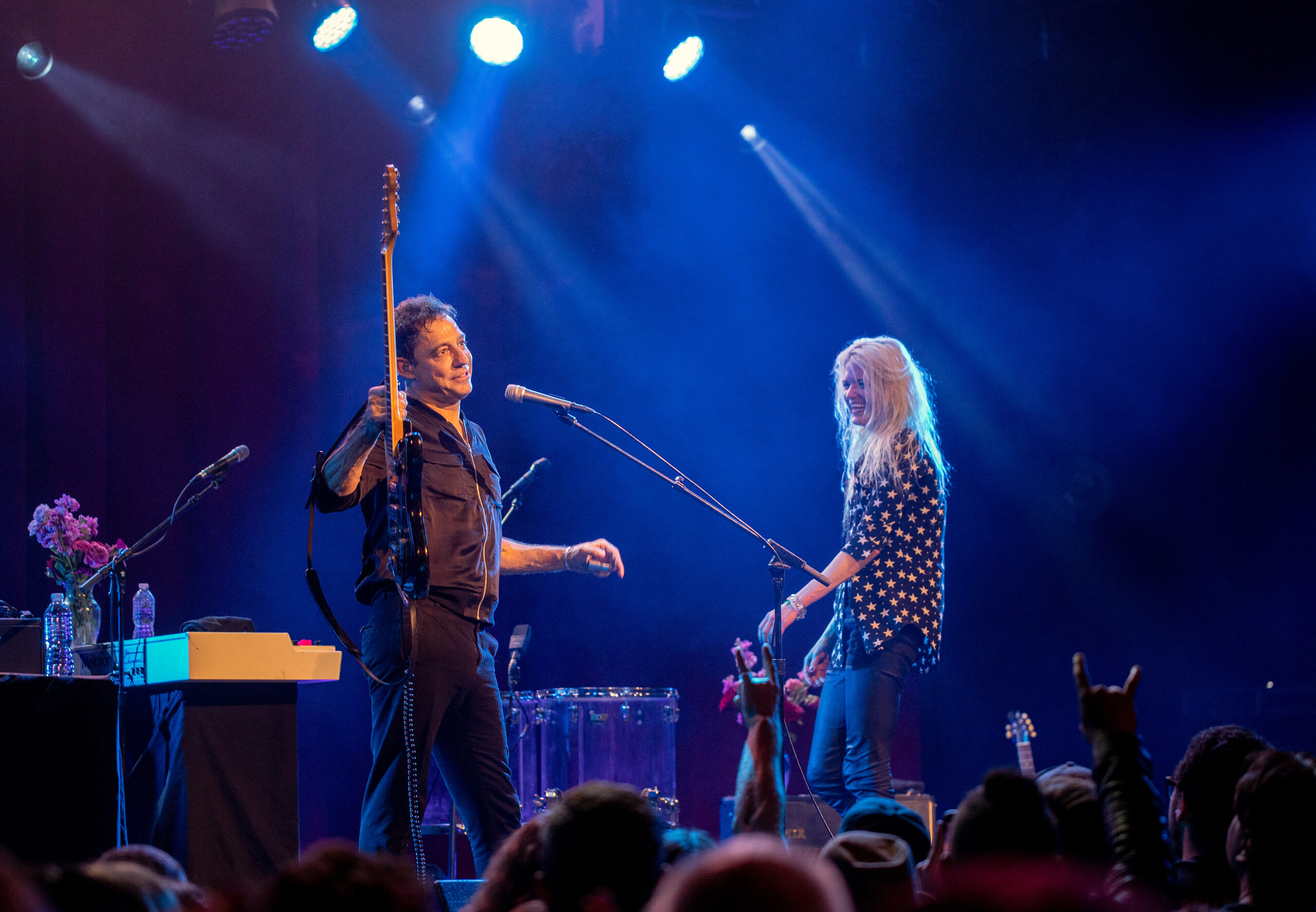
There will be more pictures made in London while making their new album, and on tour in 2023. Other old habits have to be relearned.
On their last major tour in 2018, The Kills played so many festivals where the dominant rhythm was a thumping dance beat, and hardly any guitars. “We would be the first band to go on stage with a guitar or actual instrument, and it annoyed me,” says Hince. “It made me feel like this is archaic. This is like going on stage with a harpsichord or something.”
As the band began writing for the next album, and sketching out ideas in the studio over the last three years, he says he was feeling a “dislike of the guitar. I felt like it was hindering me. Every time I picked up a guitar, my fingers went to the same kind of chord shapes. And I felt really liberated by writing songs without guitar.”
The five shows The Kills performed this month has changed that. Stripping things back to their essence has been inspirational. The Kills say they are feeling recharged as they head to London to complete the album.
“Just from doing these shows, my love for guitar and the importance of guitar to me has been absolutely refreshed,” says Hince. “And as people have constantly told me, it’s what I do.”
“It’s been such an insular time, where we’re just working alone and you don’t see anyone’s faces,” says Mosshart of the COVID years. “Feedback is important. And to look out at the crowd … it just gives you more energy for the project, and a true excitement to get these songs out.”

